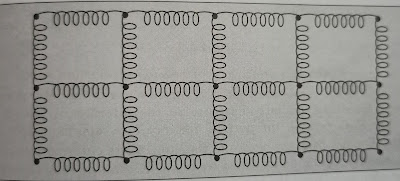Lattice vibration

LATTICE VIBRATION:- E very atom has a tendency to vibrate about their mean position at temperature above zero Kelvin. The mean position is referred as the Bravais lattice site . These vibrations occur due to interatomic interactions. As the atoms in the solids are present at lattice sites , so these vibrations are called lattice vibrations. Fig.1 Lattice vibration are the results of absorption of heat energy. A lattice is an array of atoms connected with each other by elastic springs or strings . Here all the atoms present at lattice sites are coupled and the motion of one single atom is shared by the neighbouring atoms. Thus the crystal vibrates on a whole . The dynamic external forces which are responsible for the vibrations obey Hooke's law. It is assumed that the amplitude of the vibrations are small as compared to the interatomic spacing. Harmonic approximation is valid for lattice vibrations. T...
